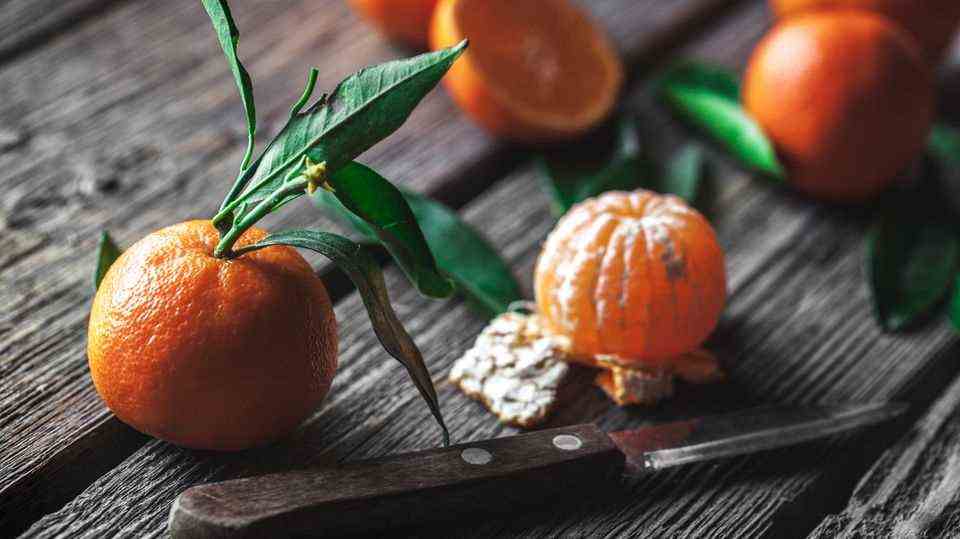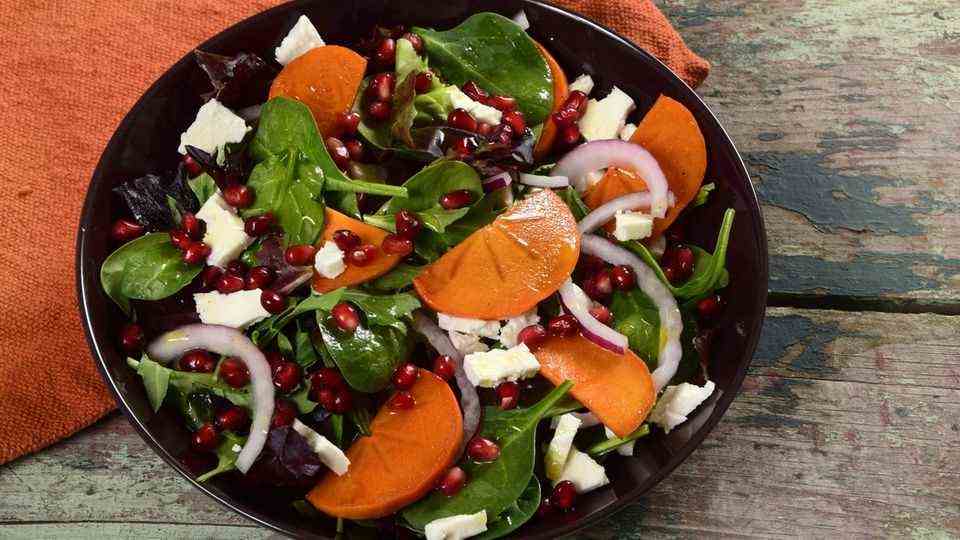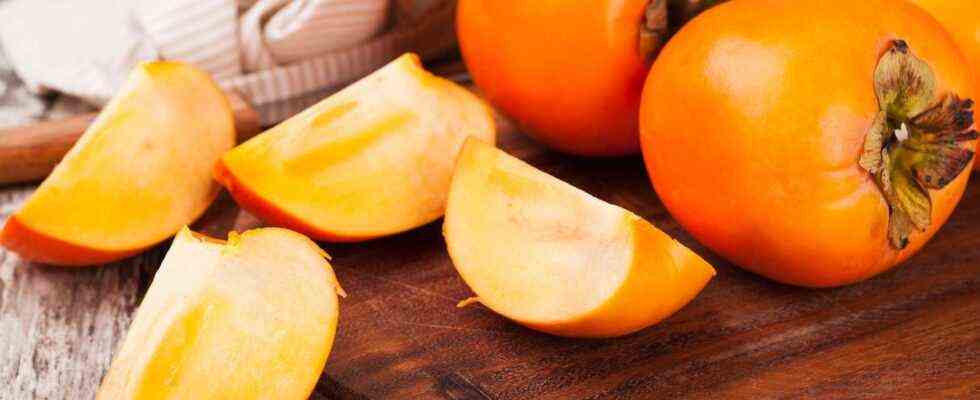Fruit of the gods
Three delicious recipes: Why the persimmon deserves more attention
The persimmon is also called “food of the gods” – reason enough to pay more attention to it
© gresei / Getty Images
From October it is called “Kaki Time”. The exotic fruit immediately catches the eye with its pungent orange color. It is also a pleasure in terms of taste – and is used in both sweet and savory recipes.
Inconspicuous and yet so versatile – the persimmon, also known as persimmon or sharon fruit. The fruit with the intense color is also called “fruit of the gods”. No wonder, after all, the orange pulp of a ripe persimmon tastes heavenly: pleasantly sweet, slightly like caramel and reminiscent of a mixture of tomato and apricot. Visually, the persimmon could compete with an unripe tomato – from a botanical point of view, however, it is a berry – it grows on trees.
Winter time is persimmon time
When the leaves on the trees turn golden yellow, orange and red, the persimmon season starts here in Germany: From October to the beginning of January you can find the largest selection of vitamin-rich fruits. Although the persimmon is now also imported to Germany from Spain, Italy, Israel and, from March, from Brazil, it also covers a lot of kilometers and thus loses not only its taste but also its vitamins. With a seasonal and, above all, regional diet, you support short transport routes and thus help to reduce harmful greenhouse gases. Reason enough to make the best possible use of the persimmon season and try out numerous recipes – after all, the fruit is wonderfully versatile.
Important when buying: Persimmons can sometimes be a bit bitchy – they taste tart when unripe, but when ripe they are very sensitive to pressure and mash up quickly. A persimmon has the perfect degree of ripeness when the pulp shimmers through the thin skin with a glassy shine. Since you can eat the skin of the fruit, you should make sure that it has neither bruises nor brown spots.
Healing “fruit of the gods”: origin of persimmon
As one of the oldest cultivated plants in the world, the persimmon has been cultivated mainly in Asia for over 2000 years. This is also where their origin can be found. In addition to East Asian countries, Israel and southern European countries such as Italy also cultivate the fruit today. The deep orange fruit grows on a tree up to ten meters high and is – derived from its generic name “Diospyros kaki” – also called “fruit of the gods” or “food of the gods”. For a very long time, persimmons have been said to have healing powers in Asia – especially for stomach, blood pressure, coughs and diarrhea.
What is the difference between sharon fruit, persimmon and persimmon?
The “fruit of the gods” is known under three different names. But what is the exact difference between persimmon, a Sharon fruit and persimmon? After all, the three look very similar.
Persimmon is the original name of the fruit that grows on the persimmon tree – hence the wild form of all other cultivated varieties. The taste of the flesh of the persimmon is reminiscent of apricots and pears in a not yet fully ripe form and also has a tart component due to the tannins it contains, the tannins of the fruit. The more ripe the fruit, the more tannins are broken down and the less bitter it tastes.
In the trade, however, there are mostly the relatives of the persimmon – the so-called persimmon and the sharon fruit – to buy. The “Sharon” comes from Israel and owes its name to the fertile Sharon plain in which it is grown. Compared to persimmons, the shape of the fruit is flatter and smaller, the color more yellowish than reddish. Persimmon, on the other hand, is mainly grown in Spain. It can be recognized by its elongated, oval shape, which has a light red color.
Both persimmon and sharon fruit have almost no tannins and can therefore be consumed even when they are not yet fully ripe. The flesh is very sweet and reminds a little of sugar melon and peach with a hint of caramel. Both types of persimmon can be eaten with their skin on. When it is soft, it is advisable to remove the flower base with a knife and then cut the fruit into quarters.
Full of vitamins
Persimmons are tiny nutrient bombs. With their large amount of fiber, they contribute to healthy digestion and also ensure a lasting feeling of satiety. In addition, the “fruit of the gods” contains numerous minerals, vitamins and trace elements. Their high content of provitamin A, the precursor of vitamin A, deserves special mention. Vitamin A is an essential vitamin, which among other things supports the visual process and is essential for healthy skin and mucous membrane cells. It is also rich in B vitamins and contains a lot of vitamin C. It strengthens the immune system and gets us through the cold season well.
Versatile: hearty and sweet a pleasure
Persimmons deserve more attention, not only because of their beautiful appearance, sweet aroma and health benefits. It is also very versatile and can be used in both hearty and sweet dishes.
Three delicious recipes with persimmon
1. Creamy persimmon chocolate pudding
ingredients
- 2 ripe persimmons
- 3 tablespoons of baking cocoa
- 1 tablespoon of agave syrup
- 1 pinch of salt
preparation
- Wash, peel and dice the persimmons
- Put in a blender and finely puree with the baking cocoa and a pinch of salt.
- Sweeten with agave syrup as desired and mix again.
- Spread the cream between two glasses and let it steep in the refrigerator for at least 30 minutes.
- Turn the pudding out of the mold and serve immediately.

© Paula Mitchell / Getty Images
2. Fruity layered dessert with caramelized persimmon
ingredients
- 55 grams of brown sugar
- 70 grams of spelled flour
- 50 grams of oatmeal
- 55 grams of butter
- 3 ripe persimmons
- 2 teaspoons of brown sugar
- 1 cinnamon stick
- 4 cardamom pods
- 200 milliliters of whipped cream
- 1 tablespoon of vanilla sugar
- 150 grams of Greek yogurt
preparation
- Preheat the oven to 200 degrees circulating air.
- Put the sugar, flour and oat flakes in a bowl and mix together.
- Add the cold butter, knead everything and form the crumble.
- Place the streusel on a baking sheet lined with baking paper and bake in the preheated oven for about 20 minutes. Make sure that the sprinkles don’t get too dark.
- Wash the persimmons with hot water, pat dry and cut into cubes.
- Heat two teaspoons of brown sugar in a pan until it melts. Add the persimmons and fry briefly.
- Deglaze with water and add the cinnamon stick and cardamom pods. Let everything simmer for about two minutes until the water has evaporated.
- Pour the whipped cream into a mixing bowl and whisk. Add vanilla sugar and whip the cream until stiff.
- Carefully fold in the Greek yogurt.
- Layer the dessert in glasses. Start with a layer of caramelized persimmons, sprinkle sprinkles over them and top with cream. Repeat once more with all three layers. Finally, spread a few sprinkles and pieces of persimmon on the yoghurt cream.
- Let it steep in the refrigerator for at least 30 minutes.
- Enjoy.

© RoJDesign / Getty Images
3. Romaine lettuce with baked persimmon and goat cheese
ingredients
- 2 persimmons
- 1 clove of garlic
- 2 tablespoons of olive oil
- salt
- pepper
- 200 grams of romaine lettuce
- 50 grams of pomegranate seeds
- 50 grams of chopped walnuts
- 100 grams of goat cheese
dressing
- 1 teaspoon of mustard
- 1½ tablespoons of maple syrup
- 2 tablespoons of white wine vinegar
- 6 tablespoons of olive oil
- salt
- pepper
- Dried salad herbs

preparation
- Preheat the oven to 200 degrees circulating air.
- Cut the persimmons into wedges and place in a bowl.
- Peel and finely chop the garlic and mix two tablespoons of olive oil in a small bowl. Season with salt and pepper and add the mixture to the persimmon wedges. Mix everything together well.
- Spread the persimmon wedges on a baking sheet lined with baking paper and bake for about 15 minutes, until the persimmon is lightly roasted on the outside and slightly soft on the inside.
- Take out of the oven and let cool down.
- Wash the romaine lettuce, cut off the hard stalk and cut it into small pieces.
- Roughly chop the walnuts and roast them in a pan without oil. Remove from heat and set aside.
- Halve the pomegranate and loosen the stones. Cut the goat cheese into bite-sized pieces.
- For the dressing, mix the mustard with maple syrup and white wine vinegar in a bowl. Add the olive oil and stir. Season to taste with salt, pepper and garden herbs.
- Mix the salad with the dressing and divide between two plates.
- Add the persimmons, goat cheese, pomegranate seeds and chopped walnuts to the salad and serve.

© sbossert / Getty Images



